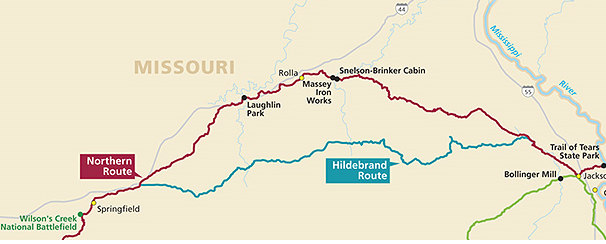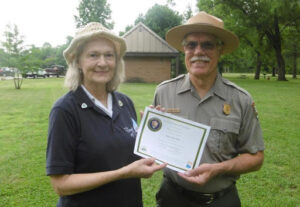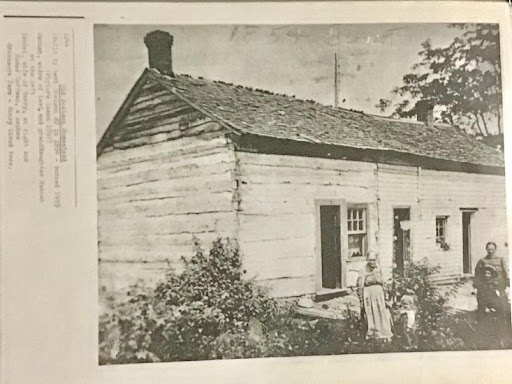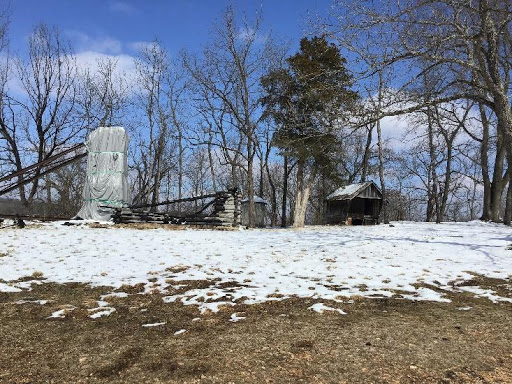
Trail of Tears
By: Kameran Brinkley
Trail of Tears National Historic Trail traces the removal of the Cherokee through our area. The Cherokee were removed from their homelands and several groups were taken across Crawford County in 1837-1839. Before the Cherokee forced removal took place, Native Americans in this part of Missouri were the Osage Indians.
Thirteen detachments of Cherokee took the overland route through Missouri. It was called the Trail of Tears because of its devastating effects. Ten of those detachments, forcibly walked through Steelville. Lt. B. B. Cannon, U. S. Army, led the first detachment of Cherokees of approximately 365 Cherokee in late 1837.
Records exist that tell of the detachments stopping in Steelville, at the Henry E. Davis homestead. The first detachment of Cherokee broke camp and dispersed in the spring, following (present day) Highway 8 to St. James, Mo. Many of the aged Indians were suffering from fatigue from the long journey. The sick and feeble were carried on wagons, a lot of them rode on horses and many walked on foot. They traveled with heavy burdens attached to their backs. Twelve to fifteen people were buried at every stop. Progress along the trail was slow, only making about 10 miles per day. The group stopped on Sunday to rest and to worship the Great Spirit.
The Trail of Tears National Historic Trail was designated by Congress in 1987 in recognition of a significant chapter in American history, to remember and commemorate the survival of the Cherokee people despite their forced removal from their homelands in the Southeastern United States.
In a story reported by Andrew Sheeley, in www.thesalemonlinenews.com, the Trail of Tears passing through Steelville has been documented and is recognized as part of the Trail of Tears National Historic Trail.
“Steelville Community Park and Recreational Area was certified June 2,[2018] as an official site of the Trail of Tears National Historic Trail. The designation came following a ceremony presided over by officials from the City of Steelville and National Park Service.”
“Deloris Gray Wood, President of the Missouri Chapter of the National Trail of Tears Association, provided the research which led to the park’s certification. She detailed her findings to the crowd June 2 and set the scene of how the Trail of Tears would have appeared as it passed by in the late 1830s.”
“Lt. Cannon of the U.S. Army led 365 Cherokees through here in 1837 and 1838 to establish a northern route,” Gray Wood said. “They were followed by 10 detachments that passed by Steelville in the winter of 1838 and 1839. That’s 10,000 people who people came through here.”
“At that time, Gray Wood said the land on which the park is now situated was the homestead of Henry E. Davis. She discovered that documentation by going through records from the National Archives. Her research reveals Cherokees camped on Davis’s land and bought supplies from him and other area homesteaders. After departing, the Cherokees traveled north [west] to the Snelson-Brinker Cabin and then passed by the Massey Iron Works going west through Phelps County.”
“Gray Wood said the northern route was pioneered by the Cherokee [who] endured significant hardships and death during a forced march through Arkansas the previous summer. She recited several passages from the military log of Lt. Cannon as evidence of the Cherokees’ suffering on the Trail of Tears. Entries from December of 1837 report the party was forced to bury several of its dead in Crawford County and they had “scarcely room on the wagons for the sick.”
“Historian Frank Norris of the National Park Service commended Gray Wood for her dedication and skill in researching the Trail of Tears."
“This is an undeniably important historic place, however, it has taken Deloris and her sleuthing to be able to show why and how it’s important,” Norris said. “For a long time, we who follow Trail of Tears matters have known 15,000-plus Cherokees where moved against their will from the south Appalachian Mountains of Georgia, North Carolina, Northern Alabama and Eastern Tennessee because the Indian Removal Act of 1830 told them they all needed to go to Indian Territory.”
“They chose different routes to come this way and they formed 17 detachments. This road right here was by far, the most important. They came up along the present day
State Hwy 8, and because of Deloris’ research, we now know a number of them camped on this ground, and we also know they bought subsistence rations. So this is an important place, it was a key part of their movement west. It took three to six months for these various detachments to walk the 800 to 1,000 miles between the south Appalachia to Indian Territory. Steelville deserves to be recognized for its important role in history as part of the northern route of the Trail of Tears.”
“Norris said the site’s recognition means it will be marked on official Trail of Tears maps and the City of Steelville is eligible to receive support to develop interpretative features such as signs and monuments. Crawford County Commissioner Rob Cummings concluded, “This is an event that needs to be remembered because it’s a sad moment in our nation’s history.”

Deloris Gray Wood, President of the Missouri Chapter of The Trail of Tears Assn., with National Park Service HistorianFrank Norris at the June 2, 2018 ceremony certifying Steelville Community Park and Recreational Area as an official site of the Trail of Tears.

Snelson-Brinker Cabin, pre-1900

Snelson-Brinker Cabin site, Feb. 2019
Sources:
https://www.fs.usda.gov/detail/mtnf/specialplaces/?cid=stelprdb5442989
Steelville Community Park Certified as Trail of Tears Site, Andrew Sheeley, Jun 19, 2018, http://www.thesalemnewsonline.com/news/local_news/article_f134206e-73d4-11e8-9fb6-2ba2f7255174.html
